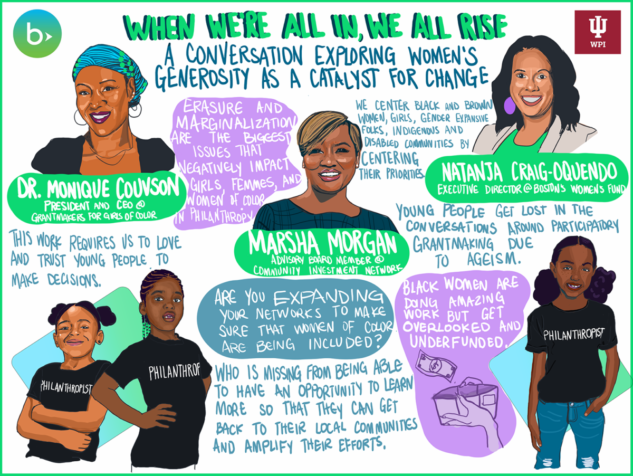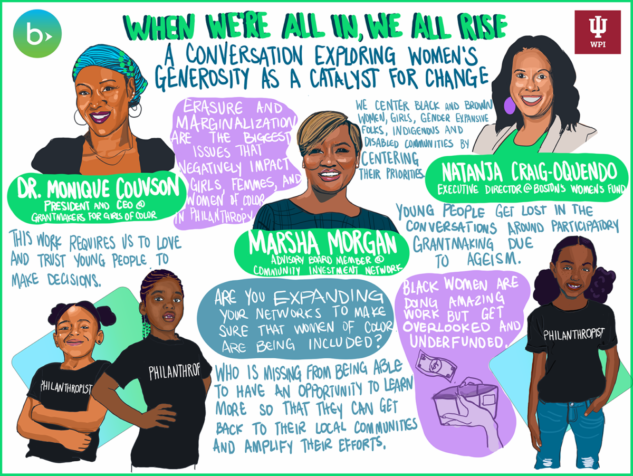Like many diversity efforts, including women’s voices in grantmaking decisions—particularly women from historically marginalized groups—doesn’t often happen organically. Typically, it takes someone seeing a situation that needs to change and doing the work to change it.
As a follow-up to the Women in Philanthropy Institute’s 2023 Symposium, hosted by the Indiana University Lilly Foundation School of Philanthropy, we gathered four dynamic grantmakers to discuss how they are doing the work to amplify female voices, especially women, girls, and femmes of color, in philanthropy.
Jacqueline Ackerman from the Women’s Philanthropy Institute moderated the panel, which featured Dr. Monique Couvson, President and CEO for Grantmakers for Girls of Color, Natanja Craig-Oquendo, Executive Director of the Boston Women’s Fund, and Marsha Morgan, Board Advisory Member of the Community Investment Network and Black Women Give Back honoree.
Based on the conversation with these grantmakers, here are four ways grantmakers can make sure all stages of their funding programs include the voices and perspectives of women.

Artwork by Toya Beacham
See Women and Girls. Intentionally.
“Those who are the topic of inquiry should be at the center of inquiry,” said Dr. Couvson. “We can’t really engage them as partners or engage them as allies or engage them as friends if we don’t see them, if we don’t recognize that they exist.”
The first step to creating more inclusive grantmaking is understanding whose voice is being lost. Recognize who is missing from your grantmaking decisions, see the value their perspective brings to your organization, and welcome them by removing barriers to their participation.
Participatory grantmaking has been a big part of the Boston’s Women’s Fund since its founding. But when Natanja first joined, she saw the barriers that kept many of the voices that they wanted at the table from participating. The organization was recruiting women who had spare time—which left out many of the younger, more diverse voices who had children, school, and multiple priorities.
Once Natanja saw who wasn’t there, she could work with her team to fix it. This meant recognizing and removing the barriers that kept these women from participating, such as transportation, childcare, and when meetings were held.
As part of their introspection, the Boston Women’s Fund also found that they weren’t hearing as much from younger women, and those who did participate felt that they were drowned out by the experiences of the older women. So, the organization created a space specifically for the younger people in their community to nominate causes and have agency over some of the grantmaking decisions.
Grantmakers for Girls of Color made a similar effort to amplify young people as thought leaders with their Black Girl Freedom Fund. With this fund, girls, femmes, and gender expansive youth of color make the final decisions.
“It requires a lot of work to prepare young people to have the skillsets to make these decisions,” Dr. Couvson said. “It requires us to love and trust young people to make these decisions. It requires us to cede power and say, ‘You know this community. You know what you need.’”
Once you include these voices and understand the value their perspectives bring to your decision-making process, you can approach the women, girls, and femmes of color in your community as partners, and see them worthy of investment.
Build Trust Through Relationships
“There have to be conversations about who philanthropy, as a sector, trusts and who we don’t trust,” said Natanja. “What happens when we move past allyship and into friendship?”
Seeing women, girls, and femmes as an essential part of your community is the first step. Now comes the hard work of building meaningful and authentic relationships. Through those transformational conversations with your community, you can ask how your organization can show up better and what support they actually need.
Trust doesn’t come easily with communities that are often marginalized. Show that your organization is willing to do the work—and that your DEI statement is not just words on a website—by finding opportunities to share power with community leaders.
According to Marsha, grantmaking organizations should look for ways to grow their Board and review committees to include community leaders. Be flexible in what work needs to be done and how that work should look. “If you are not listening to your community partners—or don’t know who those leaders are who are actually on the ground doing the work—that is a missed opportunity. You will never be able to move the needle systemically and make the changes you want to see in your community if you are not talking to the experts doing the work,” Marsha said.
For grantmaking organizations that are new to a community, don’t be afraid to explore in partnership with other organizations that have already built trust with the group you are trying to reach.
The Grantmakers for Girls of Color noticed that they weren’t reaching Indigenous girls with their programs. They didn’t have the relationships, and they weren’t seeing indigenous girls applying. “It’s not about whether we trusted them,” Dr. Couvson said. “It was about whether they trusted us.”
So, G4CG set out to identify organizations that the group did trust and move money out to those organizations. In building these relationships, they learned that they needed to change the way they spoke to these communities and to take a more multigenerational approach because the girls’ families are a core part of their lives.
It was like trying to visit someone’s house when you’ve never met them. “You don’t just show up. You try to get to know them and then they will invite you to their home,” Dr. Couvson said.
G4CG’s New Songs Rising initiative, which focuses on uplifting and resourcing indigenous girls, has awarded $2.7 million to date.
Know Your Stories, Quantitatively and Qualitatively
“When we are thinking about how we collect this data and how we quantify this impact, it’s important to qualify it and be able to tell these stories,” said Marsha. “How can we make sure we are capturing the incremental stories and the impact we are having over time?”
Now that you know who was missing from your grantmaking processes and you’ve done the work to bring them to the table, the next step is to understand how you are serving them and the long-term impact your organization is making. Because when you are focused on social change, the work you do won’t always show up annually. But they are obvious in the experiences of those your programs touch.
At G4GC, they don’t consider the work they do as charitable giving. They see it as investing, and their grantees and donors as their co-investors. Because it is the girls, femmes, and gender expansive youth of color that make the decisions for their Black Girl Freedom Fund, they get to see the power they have as a community. Through this framing, the young people who participate in their grantmaking have started adopting language that has traditionally been reserved for a different community.
“We had a rural girl from Mississippi tell us that she never thought that a Black, rural girl from Mississippi could be a philanthropist,” Dr. Couvson shared. “But today, when she introduces herself, she includes the term ‘philanthropist.’”
As part of their grantmaking process, the Boston Women’s Fund surveys their grantees several times a year. It helps them make sure they are meeting the needs of their grantees, and it helps collect some of the stories they may not get through the regular reporting.
In addition to your own stories of impact, another way you can support women’s voices is to lift the stories of your communities. Recognize the work women of color are already doing in your community, even if it’s not directly related to your grantmaking. By sharing these stories, you can inspire others to continue the work they are doing, or even inspire a young person to take an idea and make it a reality.
Rethink Risk
The grantmaking status quo has gotten us to this point—where women and girls of color receive a fraction of a fraction in funding. As part of the larger discussion about where funding is going and why, take this opportunity to rethink the rules you have as part of your grantmaking and what is the actual risk you are trying to mitigate.
During the conversation, Natanja shared that she saw herself in many of the examples shared by her fellow panelists. She once was the 15-year-old Black girl who didn’t understand the power in her experience, and that renews her conviction in the work she does every day.
“When you take a bet on me, are you failing? No,” Natanja said, speaking of her younger self. “Will something go wrong? 100 percent. Will we get through it? 100 percent.”
Spend time with your leadership to understand where the fear is coming from when you think about changing how you do your grantmaking. How are your values showing up in your actions? According to Marsha, you need to be intentional if you want to move past the status quo.
“How can I get outside of my box in my world to be intentional about supporting a part of the sector that is doing amazing work but is often overlooked?” Marsha said. “You have to be strategic and intentional and recognize that, ’Okay, I’m not doing enough, and I can do more.’”
This type of introspection is difficult, and the process is ongoing. That idea can be daunting for many grantmakers, even if they are ready to do the work. It’s hard to begin an initiative where there is a high likelihood that you won’t get it exactly right the first time. But as Dr. Couvson said, it’s important to start.
“A lot of us hold on to information and think we can’t start. Start,” Dr. Couvson said. “When you start, start in partnership with an organization that has the relationships so that you can continue to grow and continue to explore. Don’t consider this a stagnant process. Consider this a continual process.”
Structure some of the measures of success so it can give you the space to explore in partnership with different groups, build trust with different groups, and to distribute knowledge and resources throughout.
Watch the Webinar for More
Be sure to watch the recording of this conversation to catch all the wisdom and examples of what happens when you give agency and earn the trust of people who have historically been left out of these philanthropic decisions. You can also find further insights about the conversation through Jacquie’s LinkedIn post, “Reflections on WIP’s All In, All Rise Symposium.”

